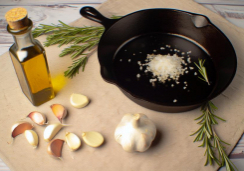Mastering Simple Healthy Stir-Fry: A Beginner's Guide
As the saying goes, 'A journey of a thousand miles begins with a single step,' and so does your adventure into the world of healthy stir-frying. You'll find that mastering this quick and nutritious cooking method isn't just about tossing random vegetables and proteins into a hot pan. It's an artful balance of preparation, timing, and flavor that you can refine with practice.
You'll need to learn how to choose the right ingredients, understand the importance of prepping them beforehand, and discover the oils that not only cook well but also benefit your health. But don't let the simplicity of the stir-fry fool you; there are nuances that can elevate your dish from good to great. Stick with me, and you'll uncover the secrets to a perfect stir-fry that's both delectable and nourishing, as well as how to adapt these techniques to suit any dietary preference or kitchen setup.
What's the key to unlocking the full potential of your stir-fry? Well, that's something we're about to explore together.
Choosing the Right Ingredients
When creating a stir-fry, it's crucial to start with a selection of fresh, colorful vegetables and lean proteins to ensure a nutritious and balanced dish. Your chosen veggies not only provide essential vitamins and antioxidants but also contribute to the vibrant aesthetics of your stir fry. Lean proteins like chicken breast, shrimp, or tofu, are excellent for building and repairing tissues without adding excessive saturated fats.
For stir-frying, you need an oil that can handle high heat without smoking or breaking down. Opt for oils with high smoke points, such as peanut or avocado oil, to maintain the quality of your dish and avoid the release of harmful compounds.
Don't forget to include aromatic ingredients like garlic, ginger, and scallions, which infuse your stir fry with rich, savory notes while offering additional health benefits. Garlic, for example, has been recognized for its potential to support cardiovascular health.
To elevate the nutritional value and texture, consider tossing in nuts, seeds, or crumbled tofu. These aren't only packed with protein but also provide healthy fats and a satisfying crunch.
Preparing Vegetables and Proteins
Before firing up your wok, ensure your vegetables and proteins are prepped into small, uniform pieces to guarantee even cooking and optimal nutrient retention. Preparing vegetables and proteins carefully is key to a successful stir-fry. When you cut your vegetables, aim for pieces that will cook at the same rate. This doesn't just help with cooking; it also means each bite is packed with a variety of nutrients.
For proteins like chicken, beef, or tofu, thinly slicing them ensures they cook quickly and stay tender. If you're using meat, consider marinating it with a bit of cornstarch or baking soda. This isn't just for flavor—these ingredients can help tenderize the meat, making it juicier and more enjoyable.
It's best to cook your meat separately first. This way, you can sear it properly without it sticking, and it'll hold its texture better when mixed with the vegetables later. If you don't have a traditional wok, don't worry. A non-stick wok or a large frying pan can still yield excellent stir-fry results.
Once everything is cooked, set aside your proteins and veggies. This will make combining them with your chosen sauce and serving over rice or noodles a breeze.
Selecting Healthy Cooking Oils
Having prepared your vegetables and proteins, it's equally important to choose the right cooking oil for your stir-fry to ensure your meal isn't only delicious but also brimming with health benefits. When you're back to basics at the stove, selecting an oil isn't just about the flavor; it's about the impact on your well-being. Here's what to consider:
- High Smoke Point: Oils like avocado, peanut, and high-oleic versions of sunflower or safflower oil can withstand the high heat of stir-frying. This prevents the oil from breaking down and releasing harmful compounds.
- Heart-Healthy Fats: Oils rich in monounsaturated fats, such as olive oil and high-oleic varieties, support heart health. Don't hesitate to add more oil if needed, as long as it's the right kind.
- Balanced Fats: Aim for oils with a good balance of omega-3 to omega-6 fatty acids. This balance is crucial for reducing inflammation and promoting overall health.
Mastering the Stir-Fry Technique
To master the stir-fry technique, start by uniformly chopping your ingredients to ensure they cook evenly and rapidly in the intense heat of the wok. This preparation is essential, as the high temperature doesn't allow much time for corrections once you begin cooking.
Heat your wok until it's smoking hot before adding oil; this is crucial for achieving the signature sear of a good stir-fry without sticking.
As you're stir-frying, use a wooden spoon or spatula to move the ingredients quickly and continuously. The wood won't scratch your wok and is durable enough to withstand the heat.
Experiment with different sauces, particularly soy sauce, as it adds a rich umami flavor that's healthier than many heavy, creamy sauces. Remember to add it sparingly to control the sodium content and maintain a balanced diet.
Keep in mind that if you're using an electric or induction stove, you may need to adjust your technique slightly. These stovetops may not get as hot as gas, so preheating your wok and managing temperatures will be key.
Lastly, don't be afraid to share your stir-fry creations. Inspiring others and exchanging tips will help you refine your skills and discover new, nutritious combinations.
Can I Use This Beginner’s Guide to Learn Mastering Simple Healthy Stir-Fry Methods?
Yes, this beginner’s guide is perfect for mastering healthy stir-fry cooking methods. With easy instructions and simple techniques, you’ll be able to create delicious and nutritious stir-fry dishes in no time. Follow the steps and tips outlined in this guide to achieve flavorful and healthy stir-fry meals.
Balancing Flavors and Nutrition
When creating a stir-fry, it's essential to blend sweet, salty, sour, and savory flavors while also packing the dish with a variety of colorful vegetables, lean proteins, and whole grains to ensure both taste and nutritional needs are met. The magic of a stir-fry comes together as you master the art of balancing these elements.
Consider these critical factors to evoke emotion and ensure your stir-fry is as nutritious as it's delicious:
- Colorful Vegetables: The rainbow of vegetables isn't just pleasing to the eye; it's a promise of diverse nutrients. Bell peppers, broccoli, and carrots add crunch and vitamins.
- Lean Proteins: Whether you opt for tofu, chicken, or shrimp, they're not only the building blocks for your muscles but also keep you feeling full longer.
- Whole Grains: Swap out white rice for brown rice or quinoa, which offer more fiber and nutrients for sustained energy.
To enhance flavors without compromising health, use herbs like ginger and garlic, along with a splash of oyster sauce, which adds depth without excess calories. Opt for healthy oils such as olive or sesame oil to add good fats.
A well-constructed stir-fry is a symphony of tastes that nourishes both body and soul.
Conclusion
Now that you've got the basics down, keep stir-frying with confidence. Remember to choose fresh ingredients, prepare them mindfully, opt for healthier oils, and perfect your technique.
Balancing flavors with nutrition doesn't have to be a chore—it's your pathway to vibrant, satisfying meals. Keep experimenting, listen to your taste buds, and adjust as you go.
You're well on your way to stir-fry mastery, nourishing both your body and your culinary curiosity. Keep it up!










